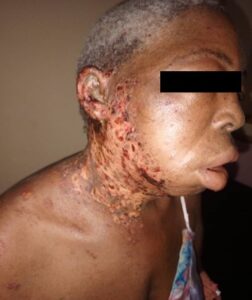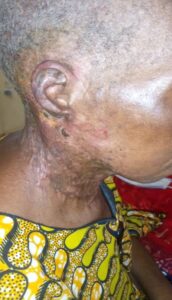Toure Mariama Saliou1*, Savane Moussa1,2, Kante Mamadou Diouldé1, Yombouno Emmanuel1, Barry Mamadou Aliou Bademba1, Toure Almyassata1, Camara Issiaga1, Keita Fatimata1,2, Diane Boh Fanta1,2, Keita Moussa1,2, Tounkara Thierno Mamadou1,2, Soumah Mohamed Maciré1,2, Cisse Mohamed1,2
1Department of Dermatology and Venereology CHU Donka, Conakry, Guinea
2Faculty of Health Sciences and Techniques, Conakry, Guinea
*Correspondence author: Toure Mariama Saliou, Department of Dermatology and Venereology CHU Donka, Conakry, Guinea; Email: [email protected]
Published Date: 26-03-2024
Copyright© 2024 by Saliou TM, et al. All rights reserved. This is an open access article distributed under the terms of the Creative Commons Attribution License, which permits unrestricted use, distribution, and reproduction in any medium, provided the original author and source are credited.
Abstract
Herpes zoster of the geniculate ganglion is characterized by severe paroxysmal ear pain accompanied by an erythematous vesicular rash involving the external auditory canal. Most people with herpes zoster have associated immunodepression of any type. We report a case of PFP in a patient living with HIV during geniculate herpes zoster.
Keywords: Herpes Zoster; Peripheral Facial Palsy; Dermatology-Venereology; Donka
Introduction
Geniculate ganglion zoster is characterized by severe paroxysmal ear pain accompanied by an erythematous vesicular rash involving the external auditory canal and/or oral cavity on the same side accompanied by peripheral facial paralysis, it is due to reactivation of Varicella Zoster Virus (VZV) in the geniculate ganglion (VII cranial nerve) [1]. This clinical form accounts for 7% of all peripheral facial paralyses [2]. Several factors are involved in VZV reactivation. These include advanced age, physical or psychological stress and immunosuppression, whatever the cause [3]. It is a major cause of morbidity, due to complications such as post-zoster neuropathy and pain, which can become disabling due to their intensity and chronicity [4]. We report a case of peripheral facial paralysis during geniculate zoster in an immunocompromised patient.
Case Report
A 66-year-old female patient consulted with neck and facial pain and postvesicular erosions, which had been developing abruptly for about 10 days with no particular pathological history. On physical examination, the facial oedema was more marked on the right hemiface, with an erosive patch extending from the auricle to the chin in a band, not extending beyond the midline, with deviation of the mouth to the left and obliteration of the right nasolabial fold. The Charl Bell sign was positive. Otoscopy revealed diffuse oedema and hyperaemia of the right external auditory canal, making it impossible to visualize the tympanic membrane. The left pinna and ipsilateral otoscopy were normal.
Biological work-up showed positive Retroviral Serology (SRV) for type 1, normal haemogram, negative Hepatitis B Virus Antigen (HBsAg), CD4 count = 524 cells/mm3. Given this clinical description, the diagnosis of geniculate herpes zoster in HIV type 1 was accepted. The patient was treated with acyclovir 2 g/day for 10 days, dexamethasone 4 mg/day per as for 7 days, with gradual withdrawal associated with local antiseptic care, pregabalin 600 mg/day and paracetamol + codeine 650 mg 3 times/day for pain management, antiretroviral treatment with tenofovir, lamuvidine, dolutegravir and rehabilitation. The course was marked by healing of the skin lesions and partial regression of the mouth deviation at D30, although the pain persisted (Fig. 1-4).

Figure 1: Erosive plaque extending from the pinna of the right ear to the chin, coexisting with banded crusts and facial oedema.

Figure 2: Day 3, the mouth is deviated to the left and the right nasolabial fold is erased.

Figure 3: Patient seen at D30 with post-zosterial scars lmyassata.

Figure 4: Slight regression of neurological signs at D30.
Discussion
Facial paralysis is a reduction or total absence of movement in all or part of the facial muscles, due to involvement of the 7th cranial nerve. It usually appears on one side of the face but may be bilateral [5]. Immunocompromised individuals are particularly at risk of developing shingles, as are patients receiving prolonged corticosteroid therapy or cancer chemotherapy, transplant patients, individuals infected with the human immunodeficiency virus or carriers of hematological malignancies [6]. Peripheral facial palsy is a relatively common condition requiring a specific diagnostic and therapeutic approach. Its incidence is estimated at around 0.5 per 100 inhabitants. Alongside idiopathic paralysis (Bell’s palsy), which is the most common cause, other infectious, traumatic, tumor or systemic causes should not be overlooked [7-9]. The main complaint in our patient was pain, which is related to damage to the sensitive branch of the facial nerve via the geniculate ganglion, leading to painful lesions in the external auditory canal, eardrum and middle third of the concha of the homolateral auricle (Ramsay-Hunt area). Motor disorders may be accompanied by alterations in lacrimal and salivary secretion and taste sensation [6]. The risk factors found in our patient were HIV infection and advanced age, which are among the main risk factors for herpes zoster in adults according to the literature [3]. The various therapeutic classes available to us do not always give fully satisfactory results and have numerous side effects, which can impair patients’ quality of life [8]. Complete recovery occurs in 67% of patients with incomplete facial paralysis and in only 10% of those with complete paralysis [5].
Conclusion
There are many aetiologies for peripheral facial paralysis and in our context, it is necessary to look for infectious causes, particularly HIV infection.
Conflicts of Interests
The authors declare that there is no conflict of interest for this paper.
References
- Giralt Sampedro I, Carvajalb G, García-Janerasc A, Faba A, Nishishinya Aquino MB. A severe case of Ramsay Hunt syndrome treated with acupuncture and associated techniques. Complementary Therp Clinical Prac. 2020;39;101-19.
- Dorsch JN. Neurological head and neck syndromes. Prim Care. 2014;41;133-49.
- Duncan CJ, Hambleton S. Varicella zoster virus immunity. J Infect. 2015;71:S47-53.
- Akono Zoua ME, Mvilongo TC, Nanfack NC, Nomo A, Sina D, Nguena MB, et al. Clinical profile of patients suffering from ophthalmic shingles at the Yaoundé central hospital. Health Sci. 2021;22:128-31.
- Ulusoy S, Özkan G, Bektas D¸ Kaynar K, Cansız M, Kazaz N. Ramsay hunt syndrome in renal transplantation recipient. Neurol Neurosurg Psychiatry. 2010;149(42):1986-8.
- Lassaletta L, Morales-Puebla JM, Altuna X, Arbizu Á, Aristegui M, Batuecas Á, et al. Facial paralysis: clinical practice guide from the Spanish ENT Society. Acta Otolaryngology Esp. 2020;71:99-100.
- Keita L, Fofana Y, Sissoko M, Traore B, Diaby MG, Cisse L, et al. Herpes zoster revealing HIV infection. Rev Mali Infect Microbiol. 2018;12:11-3.
- Maire R, Meylan P. Facial paralysis. Rev Med Suisse. 2011;7:1901-7.
- Brigitte G, Chantal L. Pain associated with craniofacial and cervical shingles. Otolaryngology and Cervicofacial Surgery 2007;124(S1):S74-83.
Article Type
Case Report
Publication History
Received Date: 01-03-2024
Accepted Date: 18-03-2024
Published Date: 26-03-2024
Copyright© 2024 by Saliou TM, et al. All rights reserved. This is an open access article distributed under the terms of the Creative Commons Attribution License, which permits unrestricted use, distribution, and reproduction in any medium, provided the original author and source are credited.
Citation: Saliou TM, et al. Peripheral Facial Palsy in Geniculate Herpes Zoster Revealing HIV Infection: A Case Report. J Dermatol Res. 2024;5(1):1-4.

Figure 1: Erosive plaque extending from the pinna of the right ear to the chin, coexisting with banded crusts and facial oedema.

Figure 2: Day 3, the mouth is deviated to the left and the right nasolabial fold is erased.

Figure 3: Patient seen at D30 with post-zosterial scars lmyassata.

Figure 4: Slight regression of neurological signs at D30.


